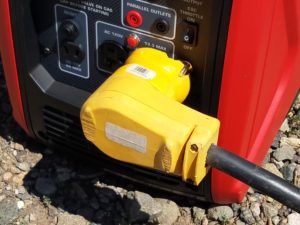Menu: Intro | Day 1-2 | Day 3-4 | Day 5-7 | Retrospective
Enjoy $10 off your order at the Strategy for Jira Store
Code: BOONDOCKING Shop Now
Valid: July 8-15, 2018
Day 3

In 2006, my stationary house was hit by lightning. One strike sent electrical outlet face plates flying across the room and broke mirrored walls. The fire department opened walls with their axes, checking for internal fire. All the house’s appliances were fried. No more fridge, no more hot water heater, etc. The only electronics that survived were my computers, because they were connected to an APC battery backup and surge suppression system. The APC took the lightning strike – not my devices.
From that experience, I don’t plug important devices directly into a wall outlet. But how do you handle surge and voltage fluctuation when you live in a travel trailer? The answer is you have to protect the entire dwelling. Power pedestals at campgrounds are notoriously problematic. They are wired incorrectly, deliver uneven current, shut off and on as they please, and frequently deliver too low voltage or too high voltage. It’s really easy to ruin everything. I will NEVER plug my travel trailer in without a Electrical Management System (EMS). The best is made by Progressive Industries. It is the one “must buy” thing for your RV! It’s saved our travel trailer and the items inside it from disaster twice. It’s worth every penny and more.
BUT you can’t use an EMS with a generator! What??? We’re going to plug the trailer into something without my precious safety system? Queue my anxiety.
Today was the big day where we’d use the new inverter generator for the first time. On the previous day, we tried plugging in an old fan first, just to make sure everything was working as expected. If the fan exploded, that would be alright but I wasn’t willing to take that chance with the entire travel trailer. Luckily, there were no explosions.
In two days, our battery drained to 11.76 volts. That’s probably lower than we should have let it go. Time will tell if we’ve damaged it. To recharge the battery to 12.45 volts (under 100%) we ran the generator for 1h 45m and used 0.5 gallons of gas.
After our morning generator fun, I joined the Convergence festivities. There 32 people and 28 “rigs” attending this off grid get together. “Rig” or “coach” is slang for your camping setup. At the convergence, we have travel trailers (towed by a hitch on the bumper) like ours, fifth wheels (towed by a hitch in the bed of a truck), and motorized RVs of all sizes and configurations. The day’s activities started with a trip to the in hot springs which included a shower. I was excited to use someone else’s shower and not waste our water! Back at camp, we ate a “Taco Tuesday” pot luck dinner.
Day 4
It’s time to charge again. Our travel trailer is wired for 30 amp, which is a different plug than a regular house outlet. We have to use an adapter to connect to the generator. The adapter cuts our amp possibilities down by half. When connected to a normal power pedestal, we can run multiple things at a time as long as we don’t exceed 30 amps. We can use the microwave with the lights on. We can use the hot water with the radio on, etc. But with the generator and only half our amperage capacity (15 amps), we have to limit what we use. We did some tests and learned we can run the air conditioning, as long as we start the fan before the compressor and NOTHING else is running. We cannot run the microwave using the generator however.
 As shown in the picture, the generator has standard US wall outlets. There are two – the left one is empty and the right is used by our yellow trailer plug and yellow adapter. If you look closely, you can see we had to file down the adapter in two places to make it fit. The outlet on the left has a red button that’s in the way and the one on the right has a grounding screw in the way. Also pictured is where we had to file off the handle on the yellow trailer plug. The plug is a replacement and was too big to store with the original handle. This is typical of the RV lifestyle. You buy something perfectly nice and intentionally ruin it to make it work.
As shown in the picture, the generator has standard US wall outlets. There are two – the left one is empty and the right is used by our yellow trailer plug and yellow adapter. If you look closely, you can see we had to file down the adapter in two places to make it fit. The outlet on the left has a red button that’s in the way and the one on the right has a grounding screw in the way. Also pictured is where we had to file off the handle on the yellow trailer plug. The plug is a replacement and was too big to store with the original handle. This is typical of the RV lifestyle. You buy something perfectly nice and intentionally ruin it to make it work.
I’m used to having my laptops plugged in all the time, so it’s pretty annoying to run out of power and have to wait until our next generator charge to be productive again. Today I got a bit of work done but was up against the laptop battery deadline. I stood up a new Jira instance but I was rushing and messed up the database part. I created the database with the wrong table collation. Jira requires “utf8_bin.” When Jira started up, it notified me of the problem. There are two options: recreate the database or change all the tables and columns. I opted for the latter. The needed queries are documented and it didn’t take long to fix. Some of the queries make the change and others generate a new set of queries to run.

Pingback: Boondocking with Jira and Confluence – Strategy for JIRA®
Pingback: Day 1-2: Boondocking with Jira and Confluence – Strategy for JIRA®
Pingback: Day 5-7: Boondocking with Jira and Confluence – Strategy for JIRA®
Pingback: Day 5-7: Boondocking with Jira and Confluence | Ultralight.Life
Pingback: Retrospective: Boondocking with Jira and Confluence – Strategy for JIRA®